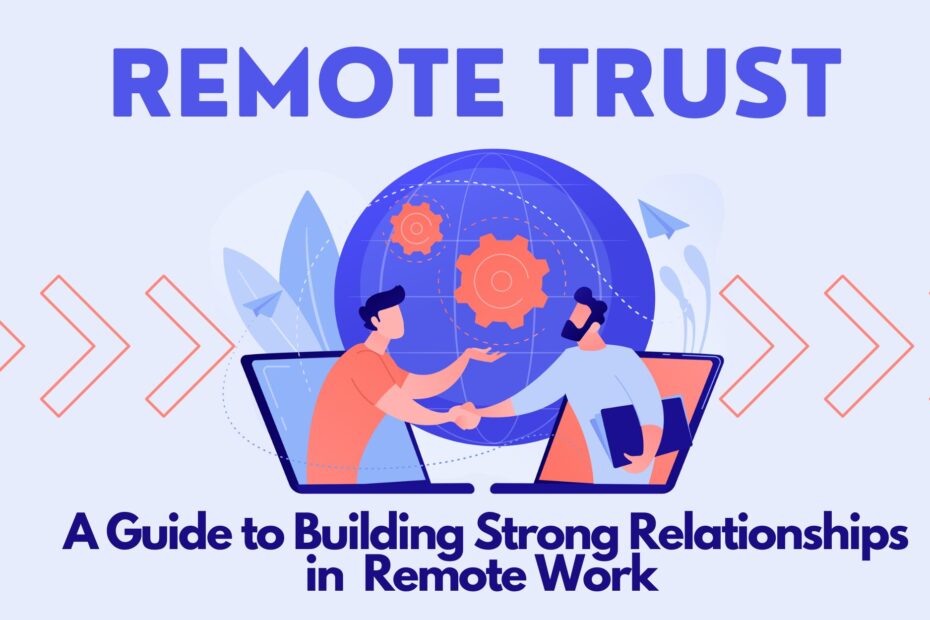Remote work: The latest fad for companies to hop like lemmings, giving employees the illusion of flexibility while secretly hoping they’ll be more productive. But while this remote gaming may have some benefits, like being able to stay in your pajamas all day, it also presents obstacles that are only exacerbated by the lack of face-to-face interaction. Trust is the glue that holds all teams together and is especially important in a remote work environment where communication is limited and difficult to achieve. In this article, we take a deep dive into the importance of trust for remote teams, the barriers to building trust in a remote environment, and building and maintaining trust among remote team members (or rather, the strangers you have to rely on) some strategic work.
Understanding the Challenges of Building Trust in Remote Teams
Building trust in remote teams is a delicate dance, a complex maze of challenges where mistakes and miscommunication are the norm. It’s like trying to release cats from a distance, with limited face time, lack of a shared culture, and accountability issues. These challenges amount to a trust-wrecking ball, making it difficult for teams to find a solid footing. But fear not! By digging into these challenges and learning to navigate them, we can build stronger, more resilient remote teams where trust is paramount.
Communication barriers
Communication in a remote team is like tightrope walking – it’s high stakes, and if you slip up, you’re doomed to fall. Except, instead of a physical fall, you’ll be plunged into an abyss of misunderstanding, miscommunication, and mistrust. With time zone differences, scheduling conflicts, and technical issues all trying to trip you up, building trust in remote teams can be a real juggling act.
Limited face-to-face interaction
In a traditional work environment, building trust is as easy as pie. You just need a cup of coffee, lunch or a chance encounter at the office. However, in the world of remote work, building trust is like finding a needle in a haystack. The lack of face-to-face interaction is like a game of telephone, where messages can easily be distorted, making it harder to develop a shared culture and collaborate effectively.
Smilies: But hey, at least no one will steal your lunch from the office fridge anymore!
Difficulties in establishing a common culture
Building a shared culture across remote teams is like trying to herd cats across different time zones and continents, all while wearing blindfolds. Good luck! But really, creating a shared culture in a remote work environment is like trying to solve a Rubik’s cube with your feet — it takes extra effort and creativity, especially when team members are as diverse as snowflakes and have limited time for face-to-face interaction.
Lack of accountability. write explanation
One of those key ingredients is accountability, it’s like the baking powder in a soufflé, it brings everything to the surface. In an office setting, it’s easy to see who’s bargaining, like looking at a soufflé in an oven, but in a remote setting, it’s like trying to make a soufflé without an oven, just different. A lack of accountability can lead to team members feeling like they’re the only ones trying to get the soufflé to rise while everyone else just sits back and enjoys the view. Finding ways to maintain accountability in a remote environment is critical, otherwise, the soufflé will fall flat.
Best Practices for Building Trust in Remote Teams
Building trust in a remote work environment is like finding a needle in a haystack. It’s like hunting for a unicorn, a mythical creature that may or may not exist. It’s difficult and time-consuming, but if you manage to find it, it will be the key to unlocking the secrets of successful and productive remote teams. In this section, we’ll venture into uncharted territory, like a group of explorers seeking that elusive trust in a remote team.
Clear and Open Communication
Clear communication, what a novel concept! Who would have thought that in a remote work environment, staying in touch with your team might actually be a good idea? Who would have thought that proactive check-ins, sharing information and actually solving problems instead of glossing over them could lead to more trustworthy relationships? Who would have thought of the revolutionary idea of regular check-ins via video calls, chat messages, or emails to keep everyone connected and informed? Clearly, these game-changing insights will revolutionize the remote working world. You may also like: Top 8 Remote Collaboration Tools for Teams
Regular Check-ins and Meetings
Regular check-ins and meetings are like the glue that holds remote teams together. Just like a crumbling house needs regular maintenance to stay in place, remote teams need regular touchpoints to maintain trust and productivity. These virtual get-togethers are a platform for team members to bond, rant and offer constructive criticism, all of which contribute to a harmonious and trusting remote work environment.
Useful resources: The importance of regular check-ins with employees
Consistent Work Processes and Expectations
Setting expectations is like having a clear picture of how the remote work machine will operate. It’s like a road map for everyone to follow, so no one ends up getting lost in the vast remote workspace. Clearly outlining how tasks are assigned, work is tracked, and guidelines for availability, communication, and response times prevent confusion and, more importantly, remote workers from feeling like they’re stranded on a desert island. Having these expectations in place will ensure that everyone is rowing the remote work boat in the same direction, and who knows, maybe even build a little trust along the way. Useful article: Preparing for the Future of Remote Work: Strategies for Employers
Foster a Strong Team Culture
A strong team culture can make remote workers feel like they are part of a community, not just some random voice on the phone. But how do you create a strong team culture without being face-to-face? Well, it’s as easy as scheduling a virtual happy hour or team-wide challenge. And, let’s not forget the magic ingredient, open and honest communication.
Note: Providing opportunities for team members to get to know each other on a personal level, such as through virtual coffee breaks or team-building games, can help build stronger relationships and create a more positive and supportive work environment.

Encourage Collaboration and Cooperation
Collaborating and collaborating in a remote work environment is the equivalent of trying to herd herds – it’s challenging, but the end result should be worth it. They say that if you can get remote team members to work together, trust will magically emerge. But let’s be honest, it will take more than a few virtual team-building events and open forums to bring that fantasy to life. Truly listening to each other takes effort, patience and willingness.
Conclusion
In conclusion, building trust in a remote work environment is like trying to fit a puzzle without all the pieces. It’s a daunting task, but one that’s critical for remote teams to avoid chaos. By addressing the elephant in the room, such as awkward silence during virtual meetings, time zone conflicts, and resistance to change, teams can build a well-oiled machine. Clear communication is key, even if it feels like yelling into the void. Regular check-ins and meetings are like group therapy sessions, and having a consistent workflow and expectations is like having a blueprint. A strong team culture is the glue that holds everything together, and collaboration is the engine that drives progress. By making trust the backbone of their work, remote teams can be unstoppable in achieving their goals.





